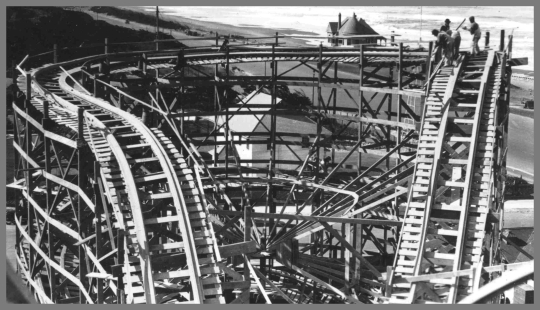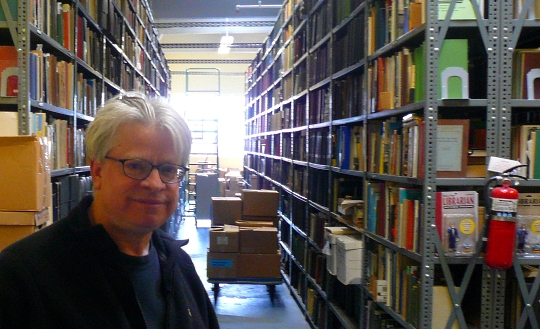Different people have different instincts when they come across something previously unknown. Some want to hoard it for themselves or a peer group, and use it for a future payoff. Others want to share. More after the jump…
Rick Prelinger does not speak kindly of hoarding, though he chooses not to speak unkindly of anyone, even those who hoard. This is not a contradiction. After all, who knows when some individual might be convinced to share that which she was previously keeping to herself?
Prelinger plans to continue his habit of sharing the hell out of what he finds, at next month’s Lost Landscapes of San Francisco, the fourth in an annual series of screenings hosted by the Long Now Foundation.
I sat with Rick recently at the Prelinger Library, “an appropriation-friendly, browsable collection of approximately 40,000 books, periodicals, printed ephemera and government documents” located in the SOMA district of SF, to chat about the upcoming event, about San Francisco, and about being an archivist.
Check out the details here.
Jeff Diehl: What is it about San Francisco and its residents that seems to breed such a robust curiosity about its past?
Rick Prelinger: There’s a lot of historical consciousness. And there’s also an interest in sharing it. Historians are less selfish here, maybe, than in other parts of the world. There’s just a real interest in propagating information.
JD: As opposed to hoarding it?
RP: As opposed to hoarding it, yeah. I don’t know information hoarders here. Local historians are really almost – they’re very forthright. They’re very forward about pushing material. You know, archival material should be shared. Archivists and collectors, that’s what they should be doing, is pushing their holdings out to the public.
JD: When that’s not done – whenever people hoard it – why are they doing that?
RP: I mean, hoarding is a loaded word. But in the old days, it used to be difficult. Material might be physically fragile, and so you didn’t want to show it to a lot of people. But now we can digitize, so people are looking at copies that don’t wear out – you know, what we call digital surrogates. So scarcity and fragility is not an issue.
In the moving image space, archivists were very worried for years about copyright. “We don’t own this. We’re going to get nailed.” But it turns out, really, that although people in the feature film space – you know, it’s true that studios still own a lot of features. There is so much stuff. There’s home movies, industrial films, actuality footage, documentary footage, news material, that typically, archives either control, or it’s in the public domain. And that’s the kind of stuff we should get out. It’s in that spirit that we’ve put a couple thousand of our pieces online – a couple thousand of our films for people to use.
JD: Talk about some of the stuff people will see at the Lost Landscapes screening on December 4th.
RP: We have a great deal of San Francisco and Bay Area material that we’ve collected. But I was especially interested in trying to get material that was shot by locals, rather than just by tourists. Tourists tend to shoot the same thing, so you’re looking at a home movie, and you see the usual drive over the Golden Gate bridge, but you’re hoping for, you know, that short pan over Crissy Field, or a neighborhood.
We’re going to have a bunch of footage from a Chinese-American family that actually lives across the street from us in the Richmond district who started shooting home movies in 1945, when they lived in Chinatown. And there’s great footage of life in Chinatown, and visits to Playland and to the playground at Golden Gate park – really beautiful, evocative, and it’s a very sweet family, too.

And I just looked at a little bit – I transferred about – gosh, seven or eight hours of it. And I just looked yesterday, and there was a fender bender at 15th and Balboa in the ’50s, with all these old cars all over the place, and everybody watching. There was a pickup band of kids playing on the sidewalk, both Anglo and Chinese-American kids all playing music together, just on the sidewalk, on 15th Avenue in the early ’60s.
JD: How’s the quality of the footage?
RP: It’s 8 millimeter, so there’s limitations, but it has – you know the color’s beautiful, and it’s, like personal expression. It’s like the camera is an extension of the hand and the eye. It’s not quite as formal as 16 millimeter, so it’s really wonderful. We have some of the demolition of Playland this year. There’s color footage from the ’40s of the Belt line railroad on the streets of South of Market, which I’ve never seen before. There’s a bunch of footage shot from boats showing the city from some interesting perspectives.
There’s some great rides around town that we haven’t seen before. This year now that we’re opening up to 8mm, there’s just a profusion of new imagery. A friend of ours, Scott Stark, who’s an experimental filmmaker in town, who’s been active for many years, has collected home movies, and Scott has lent us some of his material, including some great stuff that we’re going to have a hard time identifying where it’s from. I’m very eager to see that. There’s a beautiful Kodachrome gas station scene from the late ’30s, showing people filling up the car somewhere around old Bayshore, or maybe it’s San Jose Avenue, or maybe it’s the Excelsior.
I’ll be really interested to see what people say about that. It’s fun crowd sourcing in person. Imagine this room filled with people, and people’s inhibitions are down, because it’s a big room, and it’s just great when people talk back to the screen.
JD: And you live in the Richmond. Is there something special about the Richmond, why you live there?
RP: Richmond is great. It’s quiet on the residential streets, but it’s busy and full of life on the busy streets. It’s very diverse. It’s much more diverse than other parts of the city. I think it’s more diverse than the Mission in a lot of ways. It’s not as crowded. You know, you don’t have that unbelievable density that you have in the east side of town. You can walk to the ocean. You can walk to Golden Gate Bridge. We’re a block and a half from Golden Gate Park.
JD: It’s actually nice to hear you talk about it – it’s just good to know there are parts of the city that I haven’t fully absorbed. When I was walking through there just a few weeks ago to go find Lobos Creek, I was walking through parts of the Richmond and just realizing the different styles of architecture that I’d never seen before.
RP: You won’t see anywhere else in the country. Some of them are actually unique to San Francisco. You know, Mission style with Bay Windows.
There’s a lot to discover here. It’s a busy 49 square miles.
I’d love to see more water in the City. Chris Carlsson has proposed that we turn Market Street into a canal. I’d love to get the brooks back, the streams, the water supply of San Francisco. You’ve seen Lobos. It’s pretty neat there. You know, going between Sea cliff and the outlet at Baker.
Out where we live in the Richmond, the dunes are still very much present. Any time somebody excavates, it’s right in the sand. We were in Andronico’s between Funston and 14th Avenues. About a year ago, they were remodeling the supermarket, and they had the floor open to do some electrical or some venting. And like eight inches under the floor of the supermarket was the dune. There’s going to be a little bit of sand dunes in the show this year, as well.
There’s going to be a newsreel story from the 1930s showing a very early helicopter and autogyro landing on City Hall Plaza, which I don’t think had ever happened before – landing right in the middle of a city.
The funny thing about Lost Landscapes is that it would be wrong to say that it’s all about the past. It’s not intended to be nostalgic. It’s intended to be a look back at the way people lived. But I’m especially interested in it because the past can be predictive. I’m interested in looking at how the present has been constructed out of the past, and because of that, how the present is going to construct the future.
And so part of it is to show – to kind of throw some images in people’s heads, so they could think about change, and they can think about areas that they’re familiar with historically, and realize that the city that we live in now is not eternal. That it’s going to change just as much.
JD: Do you have any examples in mind of how people might frame their view of the future based on some of the archival stuff?
RP: Well, the city was rebuilt after the earthquake and fire. This is going to happen again, inevitably, at some point. The city was rebuilt as transportation modalities changed. Rincon Hill was flattened so that people could drive through it. There was the First to Second Street cut – you know, they cut Second Street through Rincon Hill, and then when it came time to build the Bay Bridge, they cut Rincon Hill down to just a little vestigial – almost a mound that could be the first support for the road as it came in off the bridge. Cities are restructured very much. It’s a pliable substrate.
Check out the details here.
Related book: Historic Photos of San Francisco
From Amazon
From Powell’s


5 thoughts on “Interview With San Francisco’s Guerrilla Archivist, Rick Prelinger”
Comments are closed.